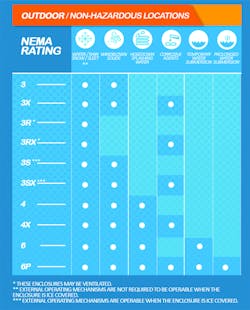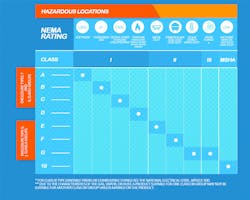Enclosures are a simple, yet essential piece of equipment. They enclose electrical conductors and equipment, preventing physical damage to components and protecting personnel from accidentally contacting energized parts. As manufacturing processes have become more complicated, enclosures have evolved with technology — transforming from simple cutouts to wooden cabinets to complex, diverse objects.
In the past, deciding on which enclosure is best suited for an application consisted of three steps: ordering the correct size, placing the equipment inside and then installers crossed their fingers and hoped that the enclosure would properly protect the electronics inside. It was a guessing game that usually led to heat overloads and even fires.
Today, enclosures are created out of more complex materials and are constructed to properly protect equipment regardless of the environment.
Choosing which electrical enclosure will be the right fit can be complicated. The following considerations should be taken into account.
Environment
The environment where the enclosure will be located is the most important factor when determining which type of electrical panel will be the most effective in protecting important components.
NEMA ratings
Environment is so influential that a set of standards was created to ensure that consumers are getting the best option for electrical protection. The National Electrical Manufacturers Association (NEMA) actively promotes standardized product specifications for electrical apparatus by establishing performance criteria for enclosures intended for specific environments. These are commonly referred to as NEMA ratings. They describe each type of enclosure in general, functional terms, specifying what it can withstand.
Courtesy of ISC Sales
Location
Hazardous locations will require more protection to prevent fires, explosions and other catastrophes that are a danger to the safety of employees and the manufacturing process. Additional equipment is required for some specialized applications, such as implementing a purge and pressurization system.
Purge and pressurization systems eliminate caustic gases and combustible materials from enclosures. First, a nonreactive gas is introduced at a positive pressure, effectively reducing the presence of hazardous gas inside the enclosure — a process known as purging. Then, pressurization takes place. Nonreactive gas is supplied with sufficient pressure to the enclosure, preventing ingress of harmful gases and objects such as combustible dusts.
Courtesy of ISC Sales
Temperature
The environment’s temperature and the expected temperatures of the electrical equipment inside the cabinet must be calculated. High heat loads wreak havoc on electrical components, but complications can be avoided by selecting the correct material.
Nonmetallic enclosures are greater insulators than metallic enclosures. Stainless steel absorbs and conducts heat, while polycarbonate enclosures do not readily allow the passage of heat.
Additional equipment can be added for temperature control, such as fans, enclosure air conditioners, enclosure heaters and heat exchangers.
Courtesy of ISC Sales
Aesthetics
The appearance of enclosures has changed drastically because the materials in which they are constructed have advanced. Many materials have available modifications that can add color to customize the appearance of the enclosure to better suit a company’s brand or to camouflage the box with its environment.
Durability and security
Some enclosure materials are more impact-resistant than others. Durability and security are important to consider for applications where enclosures are at risk of being broken into or susceptible to coming in contact with heavy equipment.
Stainless steel is more structurally sound than other steel finishes. Carbon steel is highly malleable and loses its flexibility when temperatures fall below freezing. Aluminum is highly durable and able to maintain its shape even under considerable force. When nonmetallic enclosures are properly installed and locked, they are as effective as metallic enclosures at preventing theft and tampering.
Weight and size
Weight and size play an important role in deciding which enclosure material is the optimal choice. Materials that work perfectly for smaller enclosures become impractical in terms of price and construction depending on size. For example, for a small box located outdoors, polycarbonate could be the most cost-effective option, but for a large, walk-in enclosure, steel would be a more sensible choice.
How the enclosure will be mounted must also be considered. Lightweight options are more preferable for wall or pole-mounted cabinets.
An enclosure with the exact same measurements will weigh more or less depending on the material it is constructed of. For example, an object made of steel weighing 13 pounds would comparatively weigh 4 pounds if made of aluminum, 3 pounds if made of fiberglass and a mere 2 pounds if constructed out of polycarbonate.
Design
Many enclosures need to be camouflaged to prevent theft or simply just blend in to be more appealing to the eye for customers and passersby. Highly designed enclosures are an increasing trend, and more companies are choosing to brand their equipment with logos or specific colors. Powder coating, a process used to color and further protect cabinets from corrosion, is available from many enclosure manufacturers for aluminum and steel options. Stainless steel is polished to be reflective and more attractive. Plastic enclosures offer options for coloration and clear-view window panels.
Enclosure materials
All materials used to create enclosures have their strengths and weaknesses, so knowing each material’s limitations is integral for making an informed decision.
Nonmetallic
Polymer enclosures are impervious to rust because they do not contain any metal. They are generally easily modified at job sites, provide low solar heat absorption and weigh less than their metal counterparts. They are also environmentally friendly; most are constructed with recycled parts or are biodegradable. Plastic also allows for RFI (radio frequency interference) and EMF (electromagnetic interference) waves to pass through it, which is essential for electronics that need to send and receive electronic signals.
Polycarbonate is a thermoplastic resin commonly used in wastewater treatment plants, solar power plants, marine offshore applications and manufacturing plants. Pros and cons include:
- Thermal stability
- Transparency
- Excellent impact strength
- High impact resistance
- Resistance to weathering
- Not recommended for applications that use strong alkalis
ABS (acrylonitrile, butadiene and styrene) is a thermoplastic polymer that is best suited for indoor applications. It is also FDA compliant for use in food processing. Pros and cons include:
- Flammability resistance
- Hard and rigid
- Good chemical resistance
- Prone to cracking under stress
HIPS (high-impact polystyrene) is a thermoplastic material used in low-heat applications. It is also FDA compliant for use in food processing. It can be easily fabricated and offers a low cost.
Fiberglass or glass-reinforced polyester is a thermoset polyester material reinforced with glass fibers and used in the harshest environments such as water treatment facilities, irrigation systems, oil refineries and chemical processing plants. Pros and cons include:
- Good for wet or corrosive
- environments
- Flame retardant
- Can absorb sound waves
- Resistant to many caustics and extreme temperatures
- Delamination can occur when fiberglass strands and resin separate, creating the appearance of a rough or fuzzy texture
Metallic
Aluminum is used in many indoor/outdoor applications and is a good choice for environments that contain solvents, petrochemicals, some acids and most sulfates and nitrates. It can be custom-made and offers a lighter weight and lower cost than steel.
Standard steel is powder-coated or painted to improve its durability. It is typically used in locations that have low protection requirements. It offers low cost and easy fabrication but less protection.
Stainless steel is made by adding chromium to molten steel. It comes in two varieties. It is commonly used in food processing because it can be washed down without risking the buildup of bacteria or grime.
- Type 304 is ideal for hose-down and wet areas, such as food processing, water treatment, dairies and breweries.
- Type 316 is ideal for most indoor/outdoor applications, especially marine uses.
Conclusion
Enclosures are a simple, yet effective way to keep personnel from coming into contact with live electrical components and to protect sensitive equipment from harmful objects including foreign objects, gases and water. As processes have become more complicated, so has selecting the correct enclosure for the job.
Choosing the correct electrical box can be an easy process with the help of NEMA ratings, knowing the conditions the enclosure must protect the equipment from, as well as the desired aesthetics. With this knowledge, industrial facilities can make an informed purchase and effectively protect their applications.
References
2. https://www.nema.org/Products/Documents/nema-enclosure-types.pdf.
Eleanor Sadler is a technical writer for ISC Sales, an industrial distributor for more than 30 years. She is a journalist with six years of experience in industrial and manufacturing processes. Sadler contributes to industry blogs and publications. Her articles can be found on the ISC Sales industrial blog at iscsales.com.






